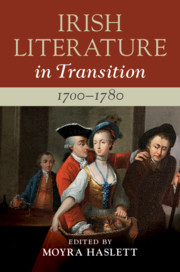Book contents
- Irish Literature in Transition, 1700–1780
- Irish Literature in Transition
- Irish Literature in Transition, 1700–1780
- Copyright page
- Contents
- Illustrations
- Contributors
- Series Preface
- General Acknowledgements
- Introduction
- Part I Starting Points
- Chapter 1 Starting Points and Moving Targets: Transition and the Early Modern
- Chapter 2 ‘We Irish’: Writing and National Identity from Berkeley to Burke
- Chapter 3 Re-Viewing Swift
- Part II Philosophical and Political Frameworks
- Part III Local, National, and Transnational Contexts
- Part IV Gender and Sexuality
- Part V Transcultural Contexts
- Part VI Retrospective Readings
- Index
Chapter 2 - ‘We Irish’: Writing and National Identity from Berkeley to Burke
from Part I - Starting Points
Published online by Cambridge University Press: 28 February 2020
- Irish Literature in Transition, 1700–1780
- Irish Literature in Transition
- Irish Literature in Transition, 1700–1780
- Copyright page
- Contents
- Illustrations
- Contributors
- Series Preface
- General Acknowledgements
- Introduction
- Part I Starting Points
- Chapter 1 Starting Points and Moving Targets: Transition and the Early Modern
- Chapter 2 ‘We Irish’: Writing and National Identity from Berkeley to Burke
- Chapter 3 Re-Viewing Swift
- Part II Philosophical and Political Frameworks
- Part III Local, National, and Transnational Contexts
- Part IV Gender and Sexuality
- Part V Transcultural Contexts
- Part VI Retrospective Readings
- Index
Summary
For W. B. Yeats, George Berkeley’s youthful reference to ‘We Irish’ marked the beginning of a national intellect based on a perceived distinction between Irish philosophical idealism and the materialism supposedly characteristic of the English. Upon this enigmatic remark of Berkeley’s, Yeats erected a system that offered to illuminate the national characteristics of eighteenth-century authors – most importantly, Swift, Goldsmith, and Burke – including a profound suspicion of abstract ideas. The wealth of eighteenth-century Irish writing, still in the process of recuperation, is not easily accommodated within Yeats’s scheme, however, more readily revealing diversity than similarity. Yet the fact of Irish birth, education, or employment, as much as their subject matter, did mark out writers as Irish, whether the identification was self-willed or imposed by those outside the island. The ways in which national identity manifested itself between 1700 and 1780 are explored through examples of prose, verse, and drama written or published both in Ireland and abroad. In so doing, the chapter outlines the first halting attempts, by male and female writers including John Toland, George Berkeley, Jonathan Swift, Henry Brooke, Frances Sheridan, Elizabeth Sheridan, and Edmund Burke, to create the idea of a national Irish literature in English.
Keywords
- Type
- Chapter
- Information
- Irish Literature in Transition, 1700–1780 , pp. 49 - 67Publisher: Cambridge University PressPrint publication year: 2020



